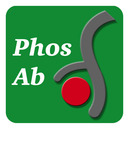
Catalog # AP1671
Actin (Tyr-53), phospho-specific Antibody
Rabbit Polyclonal
| ELISA | 1:2000 |
| ICC | 1:50 |
| WB | 1:1000 |
Size 100 μl
Species Reactivity Hu, Rt, Ms, Ck
MW 42 kDa
Actin is a major cytoskeletal protein involved in diverse cellular functions including cell motility, adhesion, and morphology. Six different actin isoforms have been identified in vertebrates. There are four α isoforms: skeletal, cardiac, and two smooth muscle (enteric and aortic) actins, along with two cytoplasmic actins (β and γ). Actin exists in two principal forms, globular, monomeric (G) actin, and filamentous polymeric (F) actin. The assembly and disassembly of actin filaments, and also their organization into functional networks, is regulated by a variety of actin-binding proteins (ABPs). Phosphorylation may also be important for regulating actin assembly and interaction with ABPs. In Dictyostelium, phosphorylation of Tyr-53 occurs in response to cell stress and this phosphorylation may alter actin polymerization. In B cells, SHP-1 tyrosine dephosphorylation of actin leads to actin filament depolymerization following BCR stimulation.
References
Winder, S.J. et al. (2005) J. Cell Sci. 118:651.
Baba, T. et al. (2003) J. Immunol. 170: 3762.
Jungbluth, A. et al. (1995) FEBS Let. 375:87.

Western blot analysis of mouse C2C12 cells untreated (lanes 1 & 3), or treated with pervanadate (1 mM) for 30 min (lanes 2 & 4). The blot was probed with anti-Actin (N-terminal) antibody (lanes 1 & 2) or anti-Actin (Tyr-53) antibody (lanes 3 & 4).

Immunocytochemical labeling using anti-Actin (N-terminal) and anti-Actin (Tyr-53) polyclonal antibodies in C2C12 cells control (left) or treated with pervanadate (1 mM) for 30 min (middle). The cells were fixed in paraformaldehyde and permeabilized in acetone. Both antibodies were used in the presence of blocking peptide: Actin (N-terminal) peptide (AX1655) or phospho-Actin (Tyr-53) peptide (AX1675), respectively (right).
*For more information, see UniProt Accession P60709
The products are are safely shipped at ambient temperature for both domestic and international shipments. Each product is guaranteed to match the specifications as indicated on the corresponding technical data sheet. Please store at -20C upon arrival for long term storage.
*All molecular weights (MW) are confirmed by comparison to Bio-Rad Rainbow Markers and to western blot mobilities of known proteins with similar MW.
This kit contains:








































